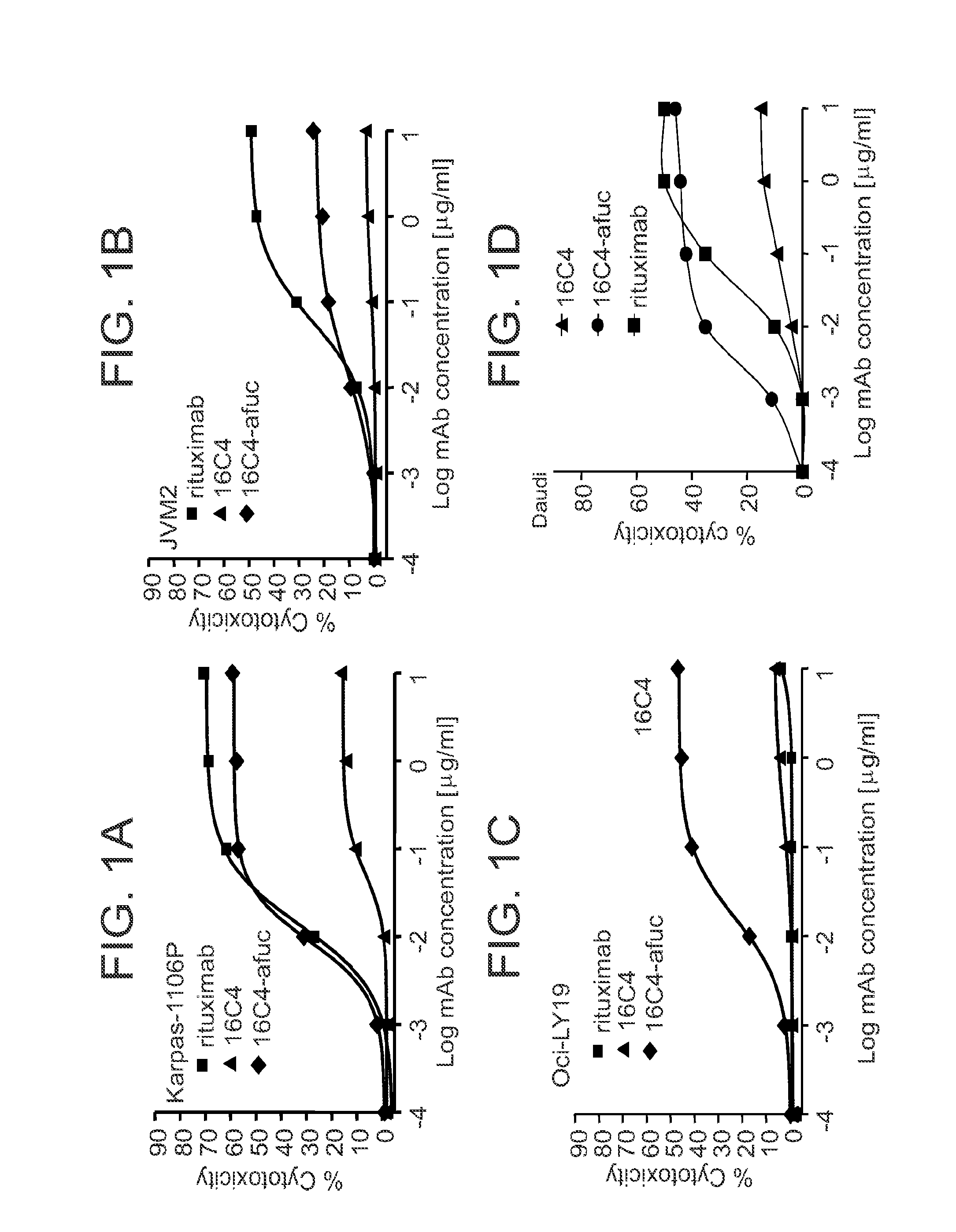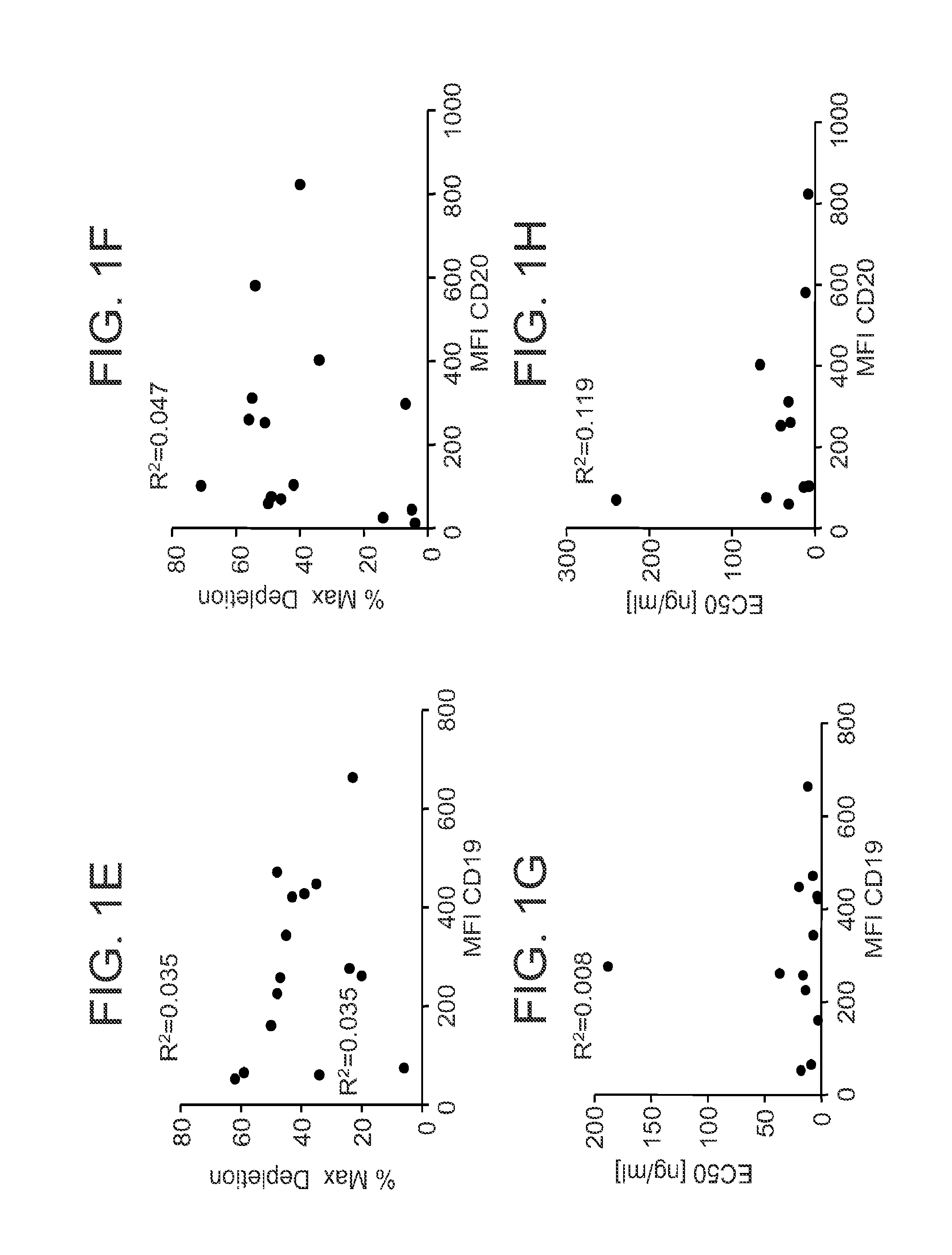Combination Therapy For B Cell Lymphomas
- Summary
- Abstract
- Description
- Claims
- Application Information
AI Technical Summary
Benefits of technology
Problems solved by technology
Method used
Image
Examples
example 1
Anti-CD19 mAb 16C4-afuc has Potent In Vitro ADCC Activity Against Multiple B Leukemia and Lymphoma Cell Lines
[0082]16C4-afuc is the afucosylated form of mAb 16C4, which was generated by humanization and affinity maturation of the mouse IgG1 mAb HB12B. (Kansas G S and Tedder T F. J Immunol, 1991; 147:4094-4102; Yazawa et al., Proc Natl Acad Sci, 2005; 102(42):15178-15183; Herbst et al., J Pharmacol Exp Ther, 2010, 335(1):213-222). Compared to the fucosylated 16C4 mAb, 16C4-afuc has ˜9-fold increased affinity to the activating human FcγRIIIA and mouse FcγRIV and enhanced ADCC effector function. In contrast to rituximab, 16C4 does not mediate CDC. (Herbst et al., J Pharmacol Exp Ther, 2010, 335(1):213-222.)
[0083]ADCC activity of 16C4-afuc was compared with that of the fucosylated precursor, mAb 16C4, in a large panel of B leukemia and lymphoma cell lines. The CD20 mAb rituximab was included in all assays as a positive control. With all cell lines tested, 16C4-afuc was significantly mor...
example 2
16C4-Afuc is Effective Against Patient Derived CLL and ALL Cells In Vitro
[0086]Given the activity of 16C4-afuc against B cell lines, the effects of CD19 mAb against primary leukemic cells were also examined. Six PBMC samples were obtained from patients diagnosed with CLL and the surface antigen densities for CD19 and CD20 were determined. As shown in FIG. 2A, B cells in these samples expressed CD19 and CD20 to varying degrees. In some of these samples the number of CD20 antigenic sites was greater than the number of CD19 sites. An in vitro FACS-based cytotoxicity assay was used to evaluate the ability of 16C4-afuc to kill B cells in the CLL samples, with rituximab as a positive control. FIGS. 2B-2D shows results from ADCC assays with 16C4-afuc and rituximab for three representative CLL samples (CLL #106, FIG. 2B; CLL #104, FIG. 2C; CLL #107, FIG. 2D). The EC50 values for 16C4-afuc ranged from 0.007 nM to 0.063 nM. In contrast, the EC50 values for rituximab ranged from 0.639 nM to 0....
example 3
16C4-Afuc Inhibits Tumor Growth in SCID-Lymphoma Models by an Fc-Dependent Mechanism
[0090]Next, the ability of 16C4-afuc to inhibit tumor growth in vivo was tested. The antitumor efficacy of 16C4 was evaluated in multiple human CD19+ lymphoma xenografts grown in SCID mice.
[0091]Some, but not all, mAbs against CD19 have anti-proliferative activity. (Ghetie et al. Blood, 1994; 83(5):1329-1336.) Previously, the mAb 16C4 was shown to inhibit proliferation of transformed B cell lines as well as primary B cell from healthy donors. (Herbst et al., J Pharmacol Exp Ther, 2010, 335(1):213-222.) In order to determine the contribution of ADCC to the anti-tumor effect, the efficacy of 16C4-afuc was compared to mAb 16C4-TM, a version of the CD19 mAb engineered for the elimination of Fc-mediated effector function. (Oganesyan et al., Acta Cryst. 2008; D64:700-704.) The antibodies were assessed in both Daudi and Raji SCID-lymphoma xenograft models at 2.5 mg / kg dosed weekly beginning on day 7 followi...
PUM
| Property | Measurement | Unit |
|---|---|---|
| Fraction | aaaaa | aaaaa |
| Time | aaaaa | aaaaa |
| Time | aaaaa | aaaaa |
Abstract
Description
Claims
Application Information
 Login to View More
Login to View More - R&D
- Intellectual Property
- Life Sciences
- Materials
- Tech Scout
- Unparalleled Data Quality
- Higher Quality Content
- 60% Fewer Hallucinations
Browse by: Latest US Patents, China's latest patents, Technical Efficacy Thesaurus, Application Domain, Technology Topic, Popular Technical Reports.
© 2025 PatSnap. All rights reserved.Legal|Privacy policy|Modern Slavery Act Transparency Statement|Sitemap|About US| Contact US: help@patsnap.com



